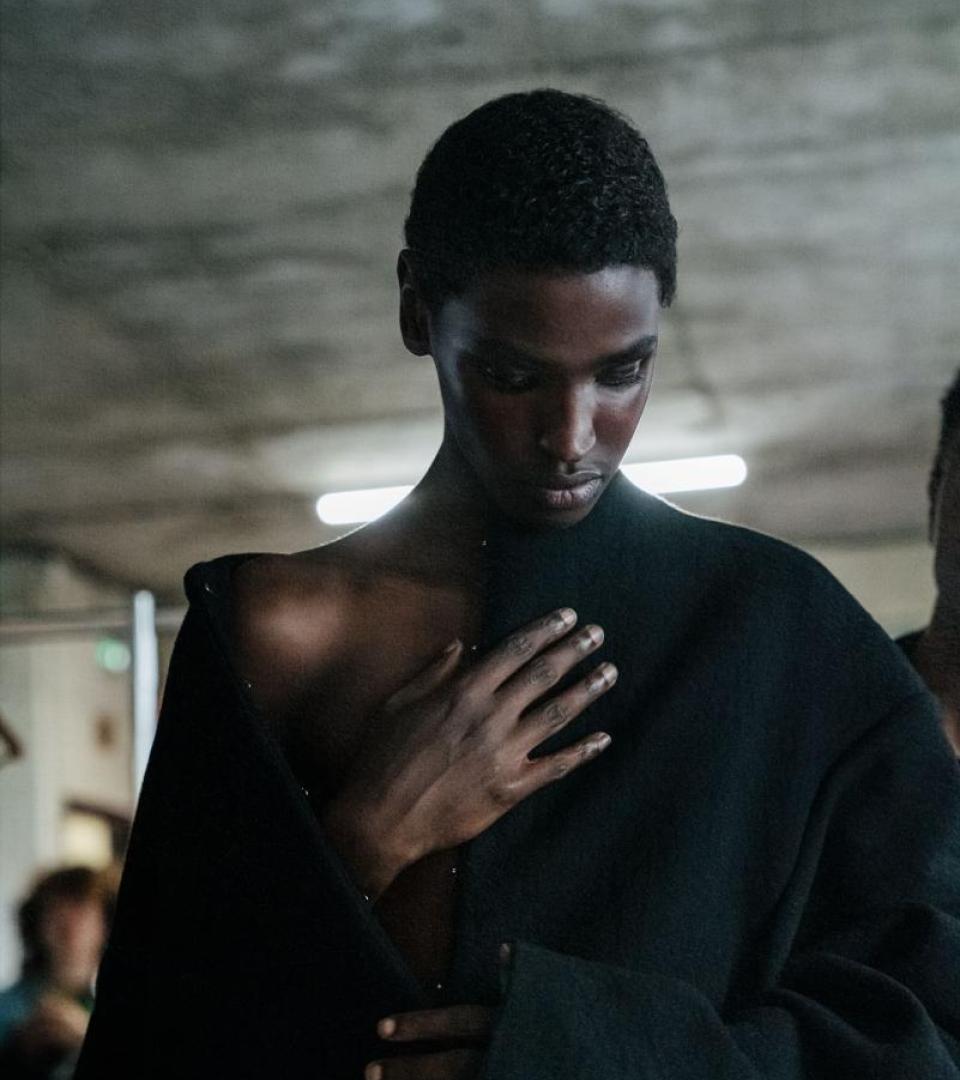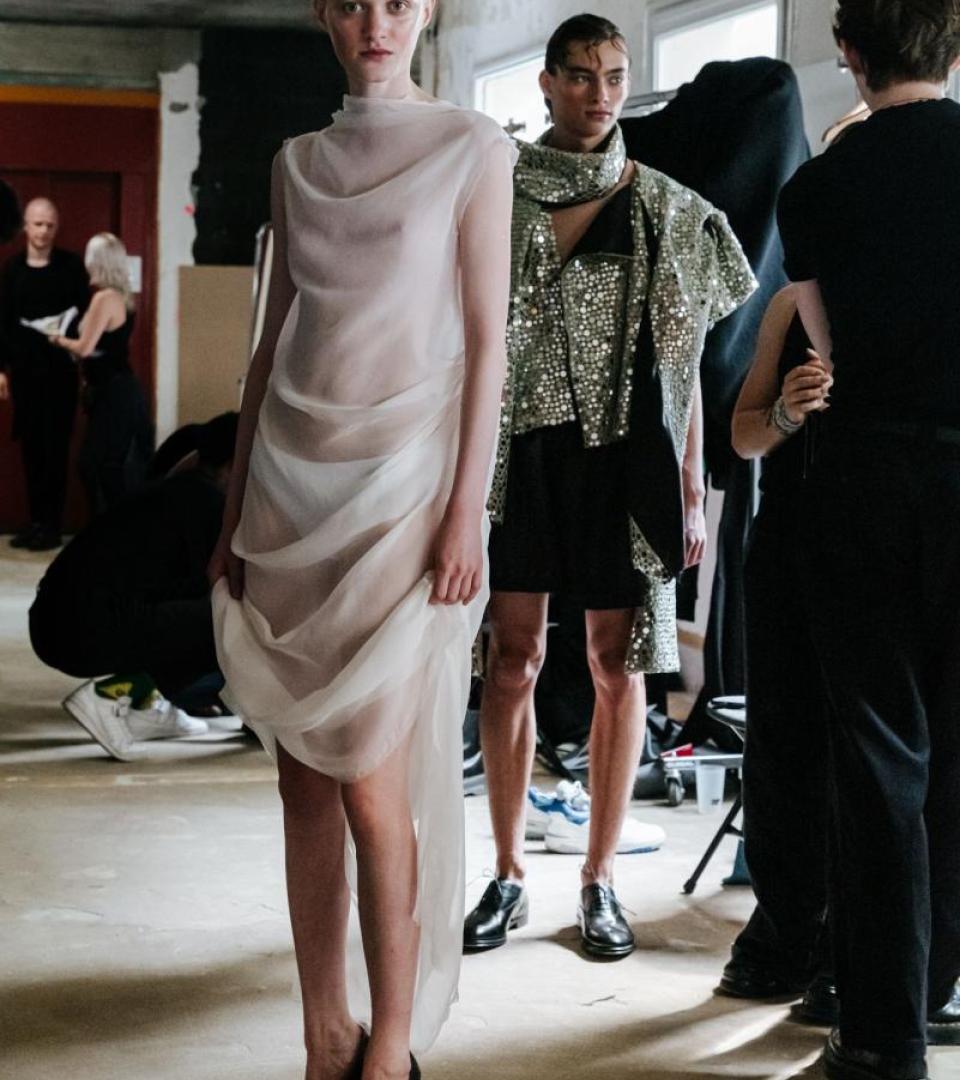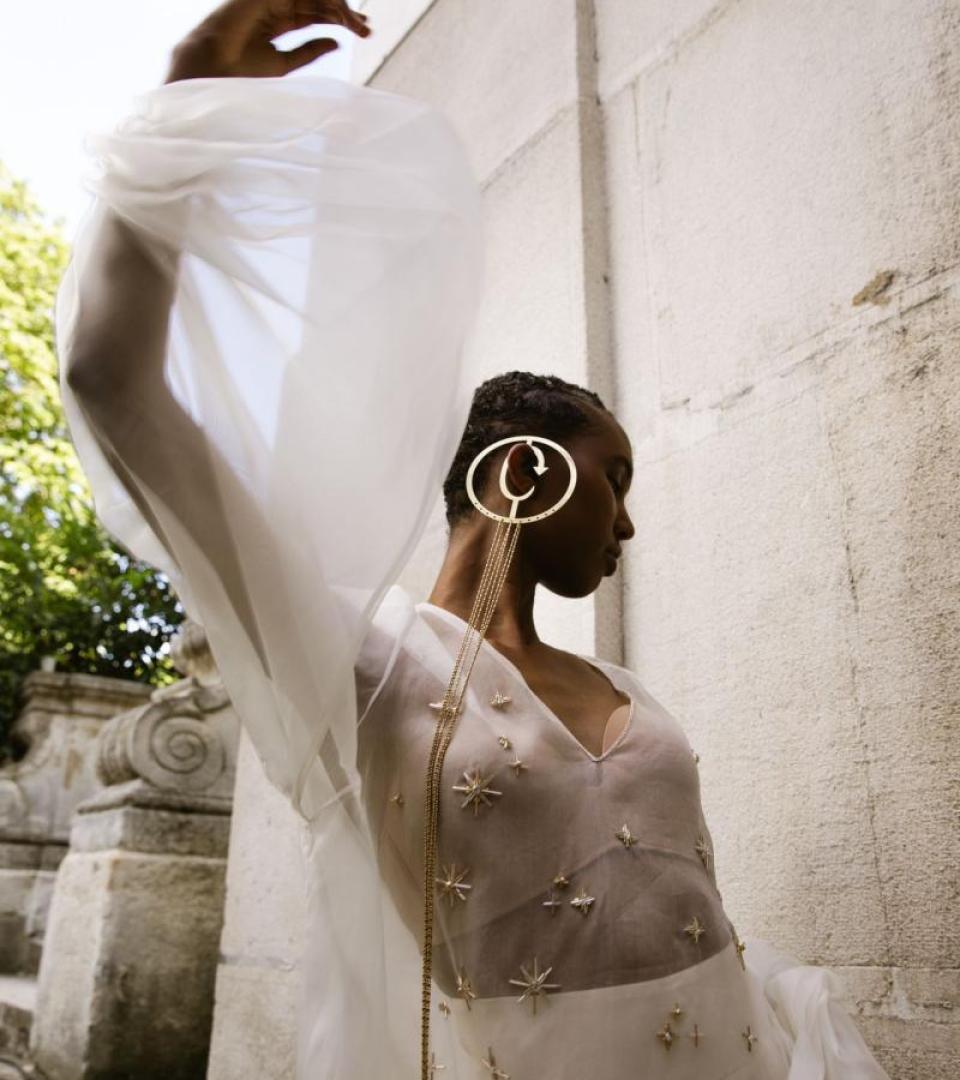Signed as pairs
This season, more than 13 fashion houses are presenting collections as duos. While the phenomenon is not new, it has become increasingly visible over the past three seasons. Creation is no longer presented as a solitary endeavour; it is now openly showcased in pairs. Could this signal a shift in the way fashion works?
By Manon Renault
At the end of June, a poster appeared on bus stops across Paris: a sculptural silhouette, sharply angled shoulders, eyes cast skywards. It was not Rick Owens, but Michèle Lamy. For Temple of Love, the first major exhibition dedicated to his work at the Palais Galliera. The Californian designer chose to step back and let his partner take the spotlight, a rare and telling gesture. “I am merely a monk kneeling before his altar,” Owens once said, as quoted by Alexandre Samson, the exhibition’s curator, in Figaro Madame last June. Lamy, often confined to vague roles that perpetuate the gendered stereotypes of “wife” or “muse,” is finally recognised as a driving force. “Michèle is intrinsically linked to Rick Owens’ story and his success. They form an inseparable duo,” Samson emphasises. For the first time, her influence is fully acknowledged. The duo came together in the late 1980s in Los Angeles. Michèle Lamy hired Owens to lead her Lamy Men line. She quickly became his mentor, introducing him to the L.A. scene through two seminal spaces: Le Café des Artistes (1989) and Les Deux Cafés (1996). She manages, edits, inspires; he designs. One cannot exist without the other.
This singular partnership, currently celebrated, reflects a moment in fashion when creation is increasingly presented publicly as a joint act. In Paris this season, nearly 13 percent of houses are showing collections designed by duos. Two minds to design, produce, embody the brand, and respond to interviews in tandem. Couples, friends, former classmates, or studio partners – these pairings no longer simply replicate the “designer and businessman” pattern, à la Yves Saint Laurent and Pierre Bergé, or, 20 years earlier, the bicameral duo of Dior and Marcel Boussac, bridging industry and couture. The model has evolved. What does it reveal about the way fashion is made today? How are roles divided: symmetrically, pragmatically, or more fused? And above all, what does this co-creation reveal about the current fashion moment?
Life and work intertwined
Perhaps the most pop, and the most precarious, form of duo is the one that merges life and work, combining the personal with the professional. In fashion, creative couples become objects of observation, not only because they share a vision, but because they embody a certain idea of unity in an age of hypervisibility.
At Loewe, Jack McCollough and Lazaro Hernandez, formerly of Proenza Schouler, have taken the reins and will present their first collection on October 3rd. They met at Parsons School in New York, co-designed their graduation collection, which was immediately bought by Barneys, and became leading figures of New York Fashion Week in the early 2000s. Their method, recounted in Wallpaper, involves sitting opposite each other at a solid wood table in their Berkshire home and drawing for 12 hours straight. A discreet, almost monastic duo, they reveal little of their private life.
At the opposite end of the spectrum, Sébastien Meyer and Arnaud Vaillant of Coperni embrace visibility. Meeting when they were 18 at Mod’Art, they founded their brand in 2013 and cultivate a highly unified public narrative including joint interviews and magazine covers. Meyer designs; Vaillant manages the business. Clear roles, yet flexible: their duo is also seamless communication team, in tune with the rhythms of contemporary media.
Finally, Hannah Rose Dalton and Steven Raj Bhaskaran of Matières Fécales embody a more radical and political creative couple. From socially contrasting backgrounds and meeting at a Montreal fashion school, they form a queer, transgressive duo that turns their own transformation into a method at the heart of their art, challenging beauty norms. Arriving in Paris in 2022 without a network, by 2023 they were supported by Michèle Lamy and Rick Owens and propelled by Adrian Joffe (Dover Street Market), developing their brand as an extension of their performance. Their relationship has become an artistic manifesto. Their second collection will be unveiled on September 30th.
A family affair
While romantic partnerships captivate, family duos intrigue. Less common, blood-related pairings, siblings or twins, offer another perspective on co-creation: less romanticised but equally structuring. The Olsen sisters, transitioning from celebrity to garment architecture with The Row, imposed in just a few seasons an aesthetic now synonymous with quiet luxury. At the opposite end, Laura and Deanna Fanning, twin sisters from Australia, based in London, have led Kiko Kostadinov’s womenswear line since 2018 with an angular, fragmented, cerebral language. This season, another sisterly duo draws attention: Alexandra and Ségolène Jacmin, founders of Belgian brand Façon Jacmin, who will present a new collection on the closing day. Their quieter story illuminates another facet of contemporary creation. Alexandra, a designer trained at La Cambre, cut her teeth at Gaultier; Ségolène, an engineer, entered through numbers, planning, and organisation. Two opposing poles but complementary. “I handled production, staff, everything less creative,” says Ségolène. “But we never stepped on each other’s toes. We learned to understand one another, to work together. And when we argue, it’s normal. Five minutes later, it’s forgotten. That’s also what being sisters is.” Their closeness does not erase the challenges of the industry. As an outsider, Ségolène had to learn the codes: “I did sales, but it took me two or three years to understand what a creative brand is. It’s not just marketing or numbers. It’s a balance between storytelling, space for creativity, and constant risk-taking.” Alexandra agrees: “We are very different, but we’ve always shared the same vision. That’s our strength.” Founded in 2016, Façon Jacmin began small: a mobile boutique, a few pop-ups, slow but deliberate growth. “We took our time,” says Ségolène. “It had to make sense, beyond our respective skills.” Alexandra adds, “If I’d been alone, I wouldn’t have lasted. Too many decisions, too much to handle. It’s essential to have someone to share it with.”
Pooling paths
Being two is not just about splitting the workload. It’s about inventing a method, finding a rhythm, composing a shared temporality. At Zomer, the label founded in 2023 by designer Danial Aitouganov and stylist Imruh Asha, collaboration is a patient weaving, rooted in a long-standing friendship. Neither couple nor siblings but a different kind of duo: born in school, extended backstage in fashion, and reconfigured into a shared language.
“Danial was always at fashion school. One day, he asked me to help him build a collection. I liked his approach to colour, texture, silhouette. So I stayed close,” recounts Imruh. In 2017, Danial presented his graduation collection at the Hyères festival, with Imruh behind the scenes. They did not win, but glimpsed the demands and promises of the industry. “We realised we lacked resources and network. We said: let’s stay together, each moving forward. We’ll come back.” They did. In 2023, Zomer debuted in Paris, quickly establishing themselves as a duo to watch, reaching the LVMH Prize finals in 2025. Their method? Continuous, sometimes silent conversation. “We often start with style, pieces we like, elements from past collections. Or it comes from a discussion, a shared idea. The concept comes after.”
The studio becomes a playground, a site for dialogue and assembly: “We lay everything on the floor. Cut. Stop. Reopen.” Working together also means discovering the other anew. “I’ve known Imruh for more than ten years. But I didn’t know his business side,” admits Danial. “You have to learn to navigate it. Together, we’re stronger. And it’s just more joyful. Imruh knows I’m sensitive. He knows the right words.” And there are still more schoolmate duos crafting singular voices; see Christa Bösch and Cosima Gadient at Ottolinger (Basel), or Bryn Taubensee and Patrick Dicaprio at Vaquera (Parsons New York).
Two, or nothing
In an industry transformed by economic, aesthetic, and social shifts, the duo is no longer an exception, but a solution. A way to navigate a world saturated with decisions, visibility, and risks. The figure of the solitary, omnipotent, visionary designer is gradually fading. Behind the brands, behind the names, there are alliances, adjustments, shared tasks, doubts, and rhythms.
One could cite Ganni, founded in 2000 by Ditte and Nicolaj Reffstrup with an eco-conscious approach, or Alain Paul, creating alongside his husband Luis Philippe. Working together also creates a cocoon where intuition remains possible, even under tightening deadlines. As American sociologist Howard Becker once explained, “Every work of art is, above all, a collective activity.”



